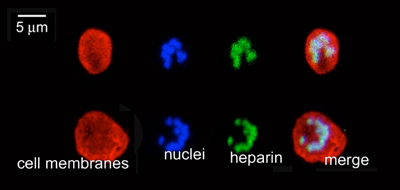Until now, heparin – which has been shown to have antimalarial activity and specific binding affinity for red blood cells infected with the Plasmodium malaria parasite – has not been explored for anti-malarial drug solutions due to its powerful anticoagulating activity. While heparin is able to block the cell adhesion of infected red blood cells to various host receptors and disrupt the growth of the pathogen, its downfall is that the quantities needed for malaria treatment would result in too much blood-thinning and bleeding. There’s also the potential risk of infection, since polysaccharides such as heparin tend to be obtained from mammals.
The IBEC/ISGlobal joint Nanomalaria unit, together with their collaborators at the Institute of Nanoscience and Nanotechnology Barcelona (IN2UB) and the Universidade Federal do Rio de Janeiro, looked to the ocean for their solution to this problem. In heparin-like molecules from sea cucumbers, red algae and marine sponges (pictured), the researchers found that the anticoagulant properties were much reduced.
“Marine organisms are a rich source of sulfated polysaccharides similar to heparin,” says Joana Marques, first author on the paper. “However, such molecules have anticoagulant activities sufficiently small to be used in circulating blood at their active concentrations without incurring the risk of internal bleeding.”
“In vitro experiments that we did with all these compounds demonstrated significant inhibition of Plasmodium falciparum growth even at low-anticoagulant concentrations, and preliminary in vivo assays in mice certainly look promising,” says Xavier Fernández-Busquets, group leader of the IBEC/ISGlobal Nanomalaria joint unit. “With heparin slowing down invasion of red blood cells by Plasmodium, the resulting prolonged exposure of the parasite to circulating lymphocytes gives the immune system a stronger chance to build up defences.”
Their discovery means that heparin-related molecules can now be explored for the design of new therapeutic approaches against malaria where polysaccharides with low anticoagulating activity could play a dual role as drugs and to encourage immune response.
Xavier Fernández-Busquets will be giving a seminar, A Short (Hi)story of Malaria, at IBEC on Friday May 20th at 10:00am.

Binding of heparin to P. falciparum merozoites inside parasitized red blood cells.
—
Source article: Joana Marques, Eduardo Vilanova, Paulo A. S. Mourão and Xavier Fernàndez-Busquets (2016). Marine organism sulfated polysaccharides exhibiting significant antimalarial activity and inhibition of red blood cell invasion by Plasmodium. Sci Rep 6, Article number: 24368